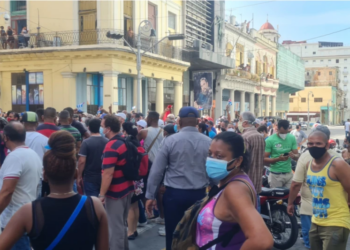
On April 1, the New York City Council made its counteroffer to Mayor Eric Adams’s proposed budget for the coming fiscal year. One of the council’s added items is $3 million for a “comprehensive master planning process for Renewable Rikers,” which would fund “technical studies, legal and environmental reviews, and community engagement” for “transforming Rikers Island into a hub for clean energy and environmental infrastructure after the closure of its jail facilities.” The same week, a non-renewed, non-transformed Rikers Island reported its fifth inmate death of the year: Dashawn Jenkins, 27, who died of a ruptured appendix after days of obvious symptoms that jail personnel should have acted upon.
The two news items—the planning process and Jenkins’s preventable death—are an encapsulation of New York City’s poisonous politics: everyone in power has declared victory over Rikers (slated by law to close in two years, though it never will) but has entirely forgotten about the day-to-day needs of the 7,100 people in jail there. The city’s elected officials have long used Rikers’s conditions as an argument to build four new jails located in central New York neighborhoods—but now that the flaws in this plan have grown impossible to ignore, no Democratic mayoral contender has proposed a serious alternative: abandon the replacement plan and instead build modern, humane jail buildings on Rikers itself.
Finally, a reason to check your email.
Sign up for our free newsletter today.
In 2019, at the height of progressive influence in New York, then-Mayor Bill de Blasio and the city council voted to close the Rikers Island jail complex and demolish existing borough jails in downtown Brooklyn and Manhattan. In their place, the city would construct four new jails in densely populated areas of Manhattan, Queens, Brooklyn, and the Bronx—Staten Island was exempt.
“With today’s vote,” de Blasio said that summer, “we are one step closer” to “creating a smaller, safer, fairer jail system,” breaking “the cycle of recidivism,” and “ending mass incarceration once and for all.” The council also made it illegal to operate jails on Rikers after August 2027. To show progress, de Blasio began closing jail facilities.
The plan relied on fanciful claims, chief among them the idea that New York could push its jail population from slightly above 7,000 inmates to just 3,300. Today, after an unsustainable period of pandemic-era decarceration, the jail population is rising again. Mayor Eric Adams has at least acknowledged reality, modestly raising the new borough jails’ planned capacity to 4,500, including some new beds at public hospitals—but that still falls far short of any serious capacity estimate based on historical patterns.
Other de Blasio-era projections are also proving fantastical. The jails were supposed to cost less than $9 billion. Now, they’re projected to cost nearly twice that (in part due to inflation). Even on an optimistic schedule, the first jail in Brooklyn won’t open until September 2029, two years after Rikers is supposed to shutter. Meeting this later deadline has required around-the-clock construction, to which neighbors rightly object. To ease Rikers crowding—which the city itself created by prematurely closing buildings—New York has had to reopen some closed facilities.
Two years ago, in an effort to feign progress, City Council Speaker Adrienne Adams re-convened the “Independent Rikers Commission,” the same group that, nearly a decade ago, first proposed closing Rikers. In late March, the commission released an update and, to its credit, partially acknowledged reality: “New York City will not meet the 2027 closure deadline,” it said, admitting what many outside observers have known for years.
The commission also conceded that the city’s jail system will need at least 5,000 beds, including 500 new “secure forensic psychiatric treatment beds.” The catch? These added beds wouldn’t be housed in the four borough jails. Instead, the commission helpfully suggested that they be located “ideally at a state facility in or near New York City.” In other words, the city is already out of space at the four new borough jails—even though not even one has been built.
With the upcoming election, now might be a good time for a mayoral candidate to say: let’s rethink this plan.
Indeed, at a forum last Thursday sponsored by Al Sharpton’s National Action Network, one candidate hinted at a possible reversal: Mayor Adams. “We’re going to spend $16 billion to build four more jails that cannot hold the population of those who are inside,” he said. “That makes no sense at all, and the plan was flawed from the beginning.” As for inmates who might be released due to future overcrowding, he added pointedly: they’re “going back to your communities.”
This candor might be refreshing—were it not for the fact that Mayor Adams is the one currently signing contract after contract to build the new borough jails. In addition to the Brooklyn facility, the city last year approved a $3 billion contract for the Bronx jail, slated for completion in November 2031, and a $4 billion contract for the Queens jail, due by Christmas 2031. Adams is also in the process of finalizing a $3.8 billion contract for the Manhattan jail, with construction set to begin this May and wrap by August 2032.
It is thus getting too late to reverse this process. Demolition contractors have already cleared the old Manhattan jail, the Tombs, for construction, knocking down a functional building that the city could have upgraded. The only way to add more beds, as the construction process advances, is through expensive change orders to the new contracts. In neighborhoods where residents already oppose new “jailscrapers,” they’re likely set to get even taller at the last minute.
Yet none of Adams’s opponents has offered a better plan. At the same Sharpton forum, former governor Andrew Cuomo declared, “Rikers has to close. Rikers has to close. It is inhumane. . . . Rikers has to close.”
Rikers, in its purposefully neglected state, is indeed inhumane. Management continues to fail and inmates continue to suffer. Tens of thousands of people will pass through Rikers between now and 2032, yet the city council and mayor refuse to invest in upgrading or rebuilding the jails there.
It’s a crueler version of an old pattern: once, urban renewal advocates would label a neighborhood “blighted”—a self-fulfilling designation that drove away residents and businesses and paved the way for government-led demolition. Rikers is now blighted by policy design.
“Every day its eight operating jails are open, incarcerated people and staff are at grave, unnecessary risk, and public safety is degraded,” says the Independent Rikers Commission’s latest report. But those conditions at Rikers aren’t inevitable; they are a choice.
Photo by ED JONES/AFP via Getty Images
Source link

















